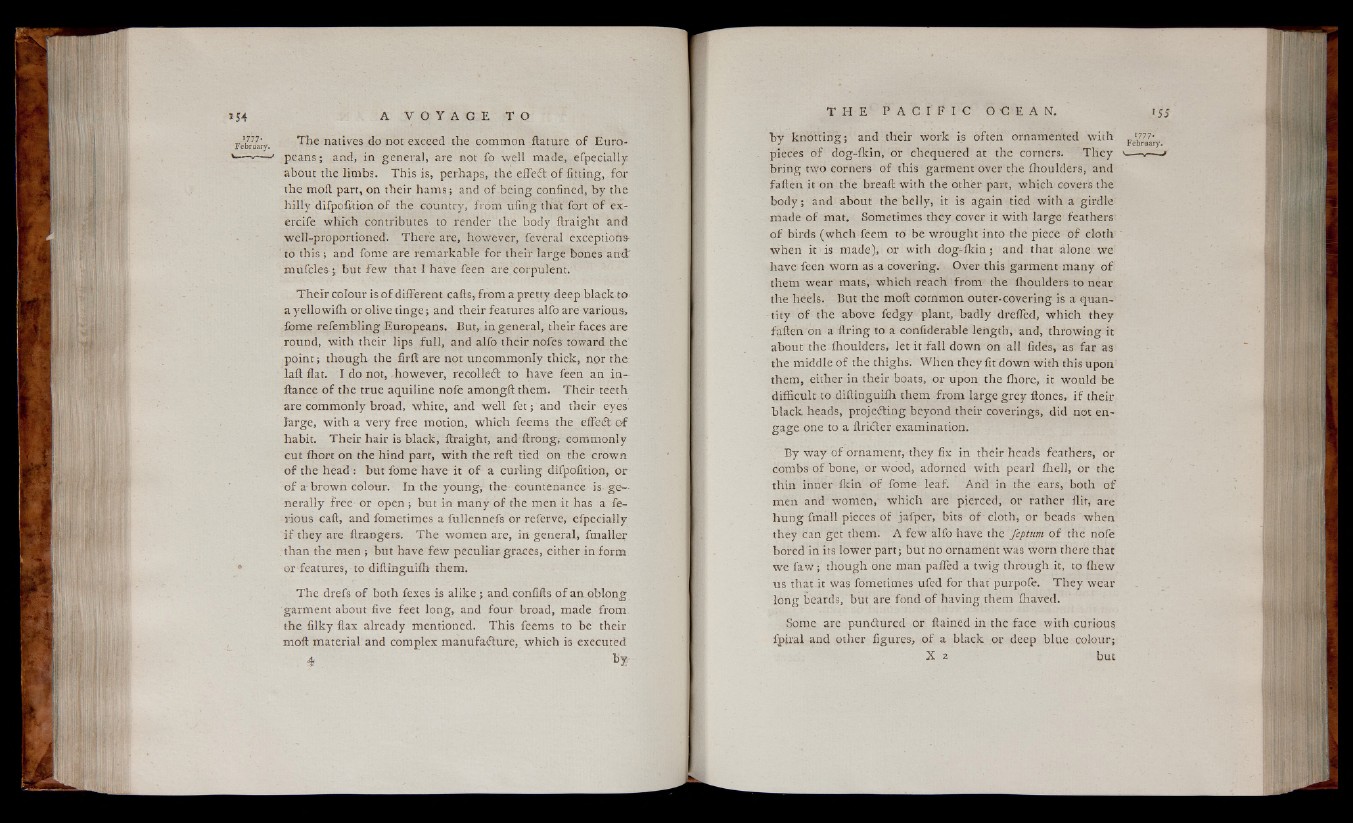
February. The natives do not exceed the common ftature of Euro-
*——» ' peans; and, in genera), are not fo well made, efpeciallyabout
the limbs. This is, perhaps, the effeCt o f fitting, for
the moil part, on their hams; and of being confined, by the
hilly difpofition of the country, from ufing that fort of ex-
ercife which contributes to render the body ftraight and
well-proportioned. There are, however, feveral exceptions-
to this; and forne are remarkable for their large bones and
mufcles; but few that I have feen are corpulent.
Their colour is of different calls, from a pretty deep black to
ayellowifh or olive tinge; and their features alfo are various,
ibme refembling Europeans. But, in general, their faces are
round, with their lips full, and alfo their nofes toward the
point; though the firll are not uncommonly thick, nor the;
lait flat. I do not, however, recoiled! to have feen an in~
ftance of the true aquiline nofe amongft them. Their teeth
are commonly broad, white, and well fet; and their eyes
large, with a very free motion, which feems the effeCt of
habit. Their hair is black, ftraight, and ftrong, commonly
cut fhort on the hind part, with the reft tied on the crown
of the head : but fome have it o f a curling difpofition, or
of a brown colour. In the young, the countenance is ge*-
nerally free or open ; but in many of the men it has a ferrous
caft, and fometimes a fullennefs or referve, efpecially
i f they are ftrangers. The women are, in general, fmaller
than the men ; but have few peculiar graces, either in form
or features, to diftinguifh them.
The drefs of both fexes is alike; and.confifts of an.oblong
garment about five feet long, and four broad, made from
the filky flax already mentioned. This feems to be their
moft material and complex manufacture, which is executed
* fcy
by knotting; and their work is often ornamented with jJ S g
pieces of dog-fkin, or chequered at the corners. They \ i—->
bring two corners of this garment over the ihoulders, and
fatten it on the breaft with the other part, which covers the
body; and about the belly, it is again tied with a girdle
made of mat. Sometimes they cover it with large feathers
of birds (whch feem to be wrought into the piece of cloth
when it is made), or with dog-fkin; and that alone we
have feen worn as a covering. Over this garment many of
them wear mats, which reach from the ihoulders to near
the heels. But the moft common outer-covering is a quantity
of the above fedgy plant, badly drefled, which they
fatten on a firing to a confiderable length, and, throwing it
about the ihoulders, let it fall down on all fides, as far as
the middle of the thighs. When they fit down with this upon
them, either in their boats, or upon the fliore, it would be
difficult to diftinguifh them from large grey ftones, if their
black heads, projecting beyond their coverings, did not engage
one to a ftriCter examination.
By way of ornament, they fix in their heads feathers, or
combs of bone, or wood, adorned with pearl flrell, or the
thin inner fkin o f fome leaf. And in the ears, both of
men and women, which are pierced, or rather flit, are
hung fmall pieces of jafper, bits of cloth, or beads when
they can get them. A few alfo have the feptum of the nofe
bored in its lower part; but no ornament was worn there that
we faw ; though one man palled a twig through .it, to fhew
us that it was fometimes ufed for that purpofe. They wear
long beards, but are fond of having them fhaved.
Some are punftured or ftained in the face with curious
fpiral and other figures, of a black or deep blue colour;
X 2 but